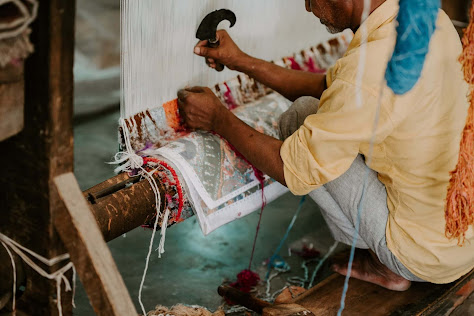Art & Craft of India
Art & Craft
Art and craft in India are not just creative expressions but living legacies that showcase the country's rich cultural heritage,
craftsmanship, and artistic diversity. From intricate handwoven textiles to
exquisite pottery, India's art forms have evolved over centuries, reflecting
the influence of different civilizations, traditions, and geographical regions.
The fusion of traditional techniques with modern innovations has made Indian
art and craft a globally recognized and cherished treasure.
India's craft traditions extend beyond textiles to include
pottery, metalwork, wood carving, and more. For instance, the blue pottery of
Rajasthan, with its distinctive cobalt blue designs on white clay, showcases
the region's unique craftsmanship and aesthetic sensibility. Similarly, the
intricate metal filigree work of Odisha, known as Tarakashi, produces delicate
jewelry and decorative items that highlight the precision and artistry of
Indian artisans. These traditional crafts not only serve as functional objects
but also embody artistic expression and cultural narratives, making them
cherished pieces of India's artistic legacy.
Terracotta
The industry often uses terracotta to make sculptures,
tile, planters, gardens, and architectural ware. When it is glazed, ware is often
referred to as 'red earthenware'. Although Terra cotta fires red the actual raw
clay can be brown, maroon, green, or red (because of high iron oxide content).
Terracotta clay is easy to sculpt into various products such as vases, kitchen utensils, tile, planters, sculptures, and bricks, etc. is often used in industry to make sculptures, tile, planters, gardens,s and architectural ware. When it is glazed, ware is often referred to as 'red earthenware'. Although Terra cotta fires red the actual raw clay can be brown, maroon, green, or red (because of high iron oxide content).
In conclusion, India's art and craft heritage is a testament to the country's creative prowess, cultural richness, and artistic ingenuity. The blend of traditional techniques with contemporary adaptations not only sustains ancient crafts but also fosters innovation and creativity in the modern era. Through initiatives promoting artisanal skills, sustainable practices, and global collaborations, India continues to shine as a beacon of artistic excellence on the world stage.
Indian art and craft, from handloom textiles to intricate pottery, epitomize the country's cultural vibrancy and artistic legacy. These crafts, rooted in tradition yet adaptable to modern influences, showcase India's enduring creativity and craftsmanship, ensuring that its artistic heritage remains a source of inspiration and admiration globally.
Go through the link below for more to know about Craft of India :
https://heyzine.com/flip-book/1a5b4166a7.html








Comments
Post a Comment